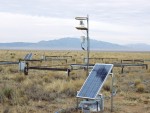The Sevilleta LTER recently started a multi-factor global change experiment in its desert grassland. The experiment simulates an environment 50-100 years in New Mexico's future, with increased nighttime temperatures, winter precipitation, and nitrogen (N) deposition. The experiment will address:
- Whether plant traits can predict shifts in community composition
- Whether these global changes will increase the establishment of creosote into these grassland communities
- Whether global changes will interact in their effects on ecosystems and plant communities
Most people know that the earth is getting warmer; many do not know that nighttime warming is occurring twice as fast as daytime warming. We apply a novel nighttime warming treatment (based on the European CLIMOOR experiment) using a large piece of aluminum fabric, similar to a ‘space blanket’, that unrolls over the vegetation at night. This fabric reflects long-wave radiation, which would otherwise be lost to the atmosphere, back onto the plants, increasing temperatures by over 1 degree C.
The last several decades have seen an increase in the frequency and magnitude of El Niño events, and the majority of global climate models predict this trend to continue. El Niños have a predictable climatic signature, increasing winter precipitation at the Sevilleta, on average, by 50 percent. Our precipitation treatment is designed to mimic the effects of El Niño in both its seasonal timing and size of its rainfall events.
As cold air drains down the Rio Grande Valley, the Sevilleta receives air-borne nitrogen pollutants from feedlots and the city of Albuquerque. Although these nitrogen inputs are small, they may have a significant effect on plant communities since Sevilleta soils have extremely low levels of nitrogen to begin with.
To determine whether species traits can predict responses to global change, we will measure traits associated with water use, nitrogen use, and phenology. We will test the hypotheses that species with higher tissue N are favored by N deposition, that drought tolerant species are favored by warming, and that species with phenology utilizing the spring growing season are favored by winter precipitation and by a longer spring growing season associated with increased nighttime temperatures.
Creosote has encroached upon about 17 million hectares of grassland in the southwestern United States in the last century. The SEV study site is dominated by black grama and blue grama, two widespread species that are economically important as cattle forage. The invasion of creosote into grasslands is associated with a decrease in forage value and increases in carbon sequestration and nitrogen leaching, which have implications for ranching, climate change feedbacks, and water quality. To determine the effects of global change on creosote establishment, we will add and monitor seed and seedlings of creosote on each plot.
This study uses a novel nighttime warming technique in an arid system to test for interactions among multiple changes in their effect on species at their range margins, where species are thought to be more susceptible to climate change. The study also provides opportunities for cross-site collaboration, with other warming experiments scheduled to start later in 2006 at the Shortgrass Steppe and Cedar Creek LTER sites.

 Enlarge this image
Enlarge this image